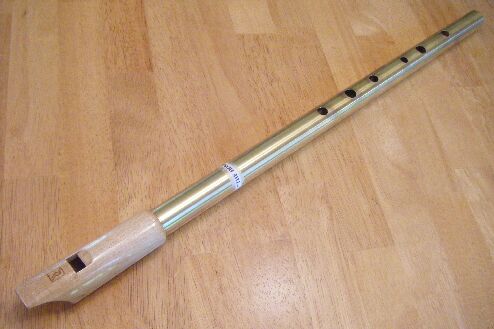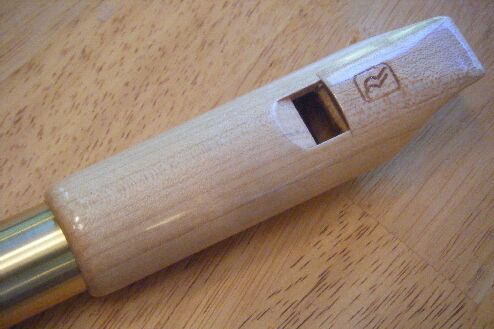Maker - Reyburn Whistles (Ronaldo Reyburn) http://reyburnlowwhistles.com
Material - Brass Body with Eastern Rock Maple Head
Dimensions: Length - 22 7/8ths" (with head pushed all the way in)
Distance between 1st and 3rd bottom holes - 3 3/16ths"
Distance between 1st and 2nd bottom holes - 1 15/16ths"
Diameter of 2nd hole from bottom - 7/16ths"
Bore - 13/16ths"
Weight - 8 oz
Price at time of review - $240 US direct from Maker
I
was about to write a review on a Reyburn wide bore Low D I've had for
awhile when I received an email from Mr. Reyburn asking if I would
write a review on his latest creation instead. Always up for trying out
a new whistle, I naturally jumped at the chance. The whistle he sent me
to review is a prototype and was not yet available for general sale at
the time
of this writing. Mr. Reyburn told me that it was "...designed to fill a niche market for those who want a loud instrument suitable
for session play. It has a very open voicing which is a bit breathy and edgy
and not as clean and pure a tone as my standard low D (which I will continue to
offer)...This whistle is designed for
those who want to really “Honk” on it as I’ve heard some do." Consequently he has dubbed this whistle, "The Honker".


Appearance:Reyburn
low whistles all have brass bodies with a unique head design
made from maple wood. The heads feature a nice gloss finish that really
shows off the wood grain to nice effect. Unfortunately, on the wide
bore model (shown in third photo above next to the Honker for
comparison) I felt the head looked overly large and awkward, similar to
but even larger than a Howard. But this new model, which I assume
features the narrower bore of the "standard" model, has a narrower head
that tapers to meet the body, giving it a sleeker much more attractive
look. The mouthpiece also tapers more dramatically and is considerably
narrower than on the wide bore model, which I feel makes it more
comfortable as well as more visually appealing. The window also has
somewhat different dimensions, having a greater distance between the
windway and the blade. The Honker is also longer in total length with
slightly larger tone holes as well. This whistle came with a nice brown
cloth sleeve bag (it actually felt like it was made from a sock like
material) with velcro closure.
Tone: I think Ronaldo hit it on the head when he described the tone of this whistle as breathy and edgy, although it manages to stay just under being too or overly breathy (comparatively, I'd put it somewhere between a chieftain OS and NR on the breathiness scale.) The tone is nicely turbulent and "dirty", with a whole bunch o' chiff. Anyone who owns or who has played a wide bore Reyburn would certainly notice that the tone of "The Honker" is quite characteristically different from it.
Volume: This whistle is Loud. Not moderate to loud, not slightly on the loud side, it's loud. I would certainly think that it would hold it's own in a session, which is, after all, what it was designed to do. The low D fundamental note definately lives up to the whistles nickname as it, well, really honks...which is to say that it is nicely full and resonant.
Backpressure/air requirement: This whistle has very high backpressure, especially in the second octave, which allows you (and in some cases forces you) to really lean into and blast it. The bottom octave has high backpressure as well, but can start to break up and distort a little too much tone wise if you push too hard, with the exception of the aforementioned fundamental note. The high backpressure also gives this whistle a fairly low air requirement, especially for a low D.
Responsiveness: This whistle is fairly responsive, but the high amount of chiff can make sometimes cause ornaments to bleed together and sound unclear. It can also tend to be a bit unforgiving in the fingering department. If you don't have all the holes perfectly, tightly sealed with your fingers it will definitely let you know by squawking quite loudly. This can make some fingering transitions a bit tricky, especially in faster tunes.
Clogging: Having a wooden head, this whistle manages to avoid the clogging when cold issues that aluminum whistles tend to have. While I did not play this whistle for an extended period of time, it only really clogged on me once, but cleared quickly. The whistle also came with a handy strip of felt that was cut so that you could pass it through the windway to swab it out.
Tuning: This whistle did have a few tuning issues, as the low A was around 15 cents sharp while the C natural was still 15 cents sharp even with the third finger down (OXXXOO). Also, the notes from the second octave F# on up hung anywhere from 15-10 cents flat depending on how hard you pushed, but as this whistle was designed to be pushed and played loud, I admit this was a little hard to call.
Sound clip: Amhran na Leabhar
Summary: I have to admit that I was slightly worried and yet partly relieved when Mr. Reyburn asked me to review this whistle instead of the wide bore I had, as I just wasn't personally a big fan of the wide bores looks or tone. But the Honker really took care of both those issues for me. Unfortunately some playability and tuning issues (which I hope would be corrected in the regular production model) tempered the positive aspects for me, bringing this whistle in at four holes. However, while I didn't get a chance to try it out personally in a session environment, I certainly think that Mr. Reyburn succeeded in creating a whistle with the characteristics he was aiming for.

Tone: I think Ronaldo hit it on the head when he described the tone of this whistle as breathy and edgy, although it manages to stay just under being too or overly breathy (comparatively, I'd put it somewhere between a chieftain OS and NR on the breathiness scale.) The tone is nicely turbulent and "dirty", with a whole bunch o' chiff. Anyone who owns or who has played a wide bore Reyburn would certainly notice that the tone of "The Honker" is quite characteristically different from it.
Volume: This whistle is Loud. Not moderate to loud, not slightly on the loud side, it's loud. I would certainly think that it would hold it's own in a session, which is, after all, what it was designed to do. The low D fundamental note definately lives up to the whistles nickname as it, well, really honks...which is to say that it is nicely full and resonant.
Backpressure/air requirement: This whistle has very high backpressure, especially in the second octave, which allows you (and in some cases forces you) to really lean into and blast it. The bottom octave has high backpressure as well, but can start to break up and distort a little too much tone wise if you push too hard, with the exception of the aforementioned fundamental note. The high backpressure also gives this whistle a fairly low air requirement, especially for a low D.
Responsiveness: This whistle is fairly responsive, but the high amount of chiff can make sometimes cause ornaments to bleed together and sound unclear. It can also tend to be a bit unforgiving in the fingering department. If you don't have all the holes perfectly, tightly sealed with your fingers it will definitely let you know by squawking quite loudly. This can make some fingering transitions a bit tricky, especially in faster tunes.
Clogging: Having a wooden head, this whistle manages to avoid the clogging when cold issues that aluminum whistles tend to have. While I did not play this whistle for an extended period of time, it only really clogged on me once, but cleared quickly. The whistle also came with a handy strip of felt that was cut so that you could pass it through the windway to swab it out.
Tuning: This whistle did have a few tuning issues, as the low A was around 15 cents sharp while the C natural was still 15 cents sharp even with the third finger down (OXXXOO). Also, the notes from the second octave F# on up hung anywhere from 15-10 cents flat depending on how hard you pushed, but as this whistle was designed to be pushed and played loud, I admit this was a little hard to call.
Sound clip: Amhran na Leabhar
Summary: I have to admit that I was slightly worried and yet partly relieved when Mr. Reyburn asked me to review this whistle instead of the wide bore I had, as I just wasn't personally a big fan of the wide bores looks or tone. But the Honker really took care of both those issues for me. Unfortunately some playability and tuning issues (which I hope would be corrected in the regular production model) tempered the positive aspects for me, bringing this whistle in at four holes. However, while I didn't get a chance to try it out personally in a session environment, I certainly think that Mr. Reyburn succeeded in creating a whistle with the characteristics he was aiming for.